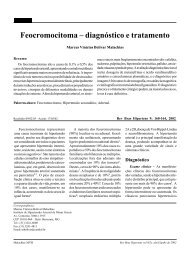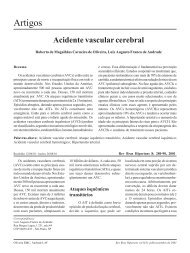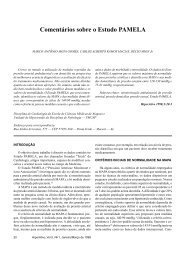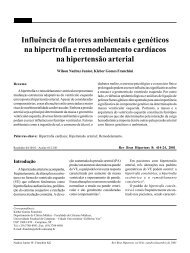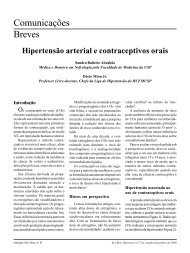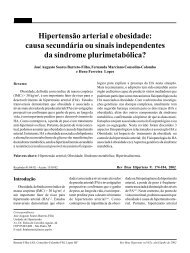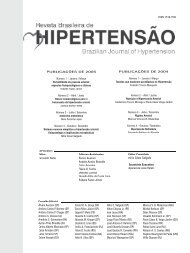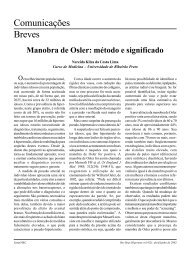Introducción Relato do caso
Introducción Relato do caso
Introducción Relato do caso
You also want an ePaper? Increase the reach of your titles
YUMPU automatically turns print PDFs into web optimized ePapers that Google loves.
Restrepo G, et al. Ausencia congénita del pericardio<br />
cida como Snoopy Sign, frecuentemente están presentes.<br />
La TC del tórax y IRM cardíaca muestran ausencia del<br />
pericardio y la interposición del teji<strong>do</strong> pulmonar como<br />
descrito anteriormente. Se observa levógiro del corazón<br />
acentua<strong>do</strong> junto con desplazamiento de la punta del<br />
ventrículo izquier<strong>do</strong> 1,2,8,9 .<br />
Un descubrimiento describió recientemente, que<br />
usan<strong>do</strong> imágenes de resonancia magnética, es la hipermotilidad<br />
del ápice y variación acentuada del volumen<br />
total del corazón entre sístole y diástole. En individuos<br />
comunes, el ápice está relativamente para<strong>do</strong> con mínimo<br />
desplazamiento (es decir, entre 1 y 7mm), consideran<strong>do</strong><br />
que, en nuestro paciente, el desplazamiento apical<br />
fue mayor (11mm).<br />
El volumen total del corazón, en individuos normales,<br />
varía durante los ciclos cardíacos con el menor volumen<br />
observa<strong>do</strong> al final del sístole y la diferencia de volumen<br />
entre la oscilación del sístole y diástole entre 5% y 11% 10 .<br />
En nuestro paciente, esa diferencia aumentó para 22%.<br />
Esa descubierta funcional por IRM indicó la presencia de<br />
un gran defecto del pericardio, nota<strong>do</strong> por la ausencia<br />
de la acción inhibi<strong>do</strong>ra del pericardio normal.<br />
El ecocardiograma bidimensional revela descubrimientos<br />
de características raras. La ventana paraesternal<br />
está desplazada para la izquierda y la ventana apical de<br />
las cuatro cámaras es encontrada posteriormente en<br />
dirección a la línea axilar media. Esos descubrimientos<br />
indicaron la presencia de ACP en nuestro paciente.<br />
También pueden ser observa<strong>do</strong>s, movimiento para<strong>do</strong>xal<br />
del septo, hipermotilidad cardíaca, dilatación del<br />
apéndice atrial izquier<strong>do</strong>, sobrecarga de volumen del<br />
ventrículo derecho e insuficiencia tricúspide grave. Una<br />
apariencia de gota de la silueta del corazón, también<br />
ha si<strong>do</strong> descrita, sien<strong>do</strong> secundaria al alargamiento del<br />
atrio izquier<strong>do</strong> y aspecto relativamente bulboso de los<br />
ventrículos, causa<strong>do</strong> por la suspensión del corazón de su<br />
pedículo basal 1-3,11-14 .<br />
Este <strong>caso</strong> ilustra la utilidad de un abordaje multimodal<br />
para el diagnóstico de ACP.<br />
Referencias<br />
1. Abbas AE, Appleton CP, Liu PT, Sweeney JP. Congenital absence of<br />
the pericardium: case presentation and review of literature. Int J<br />
Cardiol.2005;98(1):21-5.<br />
2. Gatzoulis MA, Munk MD, Merchant N, Van Arsdell GS, McCrindle<br />
BW, Webb GD. Isolated congenital absence of the pericardium:<br />
clinical presentation, diagnosis, and management. Ann Thorac<br />
Surg. 2000;69(4):1209–15.<br />
3. Rashid A, Ahluwalia G, Griselli M, Scheuermann-Freestone M,<br />
Neubauer S, Gaztoulis M, et al. Congenital partial absence of<br />
the left pericardium associated with tricuspid regurgitation. Ann<br />
Thorac Surg. 2008;85(2):645–7.<br />
4. Taysi K, Hartmann AF, Shackelford GD, Sundaram V. Conge-<br />
nital absence of left pericardium in a family. Am J Med Ge-<br />
net.1985;21(2):645-7.<br />
5. Verloes A, Perrin L, Delbecque K, Gonzales M, Demarche M, Dekos-<br />
ter G. Congenital absence of the left pericardium and diaphrag-<br />
matic defect in sibs. Eur J Med Genet. 2010;53(3):133-5.<br />
6. Luc C, Ridker PM. Echocardiographic diagnosis of congenital<br />
absence of the pericardium in a patient with VATER association<br />
defects. Clin Cardiol.1994;17(9):503-4.<br />
7. Zakowski MF, Wright Y, Ricci A Jr. Pericardial agenesis and focal<br />
aplasia cutis in tetrasomy 12p (Pallister Killian syndrome). Am J<br />
Med Genet. 1992;42(3):323-5.<br />
8. Brulotte S, Roy L, Larose E. Congenital absence of the pericardium<br />
presenting as acute myocardial necrosis. Can J Cardiol. 2007;<br />
23(11):909-12 .<br />
9. Garnier F, Eicher JC, Philip JL, Lalande A, Bieber H, Voute MF,et<br />
al. . Congenital complete absence of the left pericardium: a rare<br />
cause of chest pain or pseu<strong>do</strong>-right heart overload. Clin Cardiol.<br />
2010, 33(2):E52-7.<br />
10. Psychidis-Papakyritsis P, De Roos A, Kroft LJM. Functional MRI of<br />
congenital absence of the pericardium. Am J Radiol. 2007;189(6):<br />
W312-4.<br />
11. Centola M, Longo M, De Marco F, Cremonesi G, Marconi M , Danzi<br />
GB. Does echocardiography play a role in the clinical diagnosis of<br />
congenital absence of pericardium? A case presentation and a<br />
systematic review. J Cardiovasc Med. 2009, 10(9):687–92.<br />
12. Scheuermann-Freestone M, Orchard E, Francis J, Peterson M, Frie-<br />
drich M, Rashid A, et al. Images in cardiovascular medicine. Partial<br />
congenital absence of the pericardium. Circulation. 2007;116(6):<br />
e126-9.<br />
13. Topilsky Y, Tabatabaei N, Freeman WK, Saleh HK, Villarraga HR and<br />
Mulvagh SL. Pendulum heart in congenital absence of the peri-<br />
cardium. Circulation 2010; 121(10): 1272-4.<br />
14. Connolly HM, Click RL, Schattenberg TT, Seward JB, Tajik AJ. Con-<br />
genital absence of the pericardium: echocardiography as a diag-<br />
nostic tool. J Am Soc Echocardiogr.1995;8(1):87-92.<br />
55





